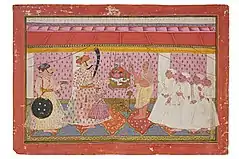Uniara (Jagir)
Uniara was a jagir of Naruka Rajputs, which lie in present-day Rajasthan, India.[1][2]

History
The rulers of Uniara are descendants of Rao Bar Singh, the eldest son of Maharaja Udaikaran of Amer. Rao Naru Singh was his grandson, from whom the Naruka clan originated. In 1638 AD, Rao Chandrabhan (1586-1660 AD), eighth in descent from Rao Naru Singh, became the first Rao of Uniara. He received four territories of Uniara, Nagar, Kakor and Banetha.[3]
Wars fought
Siege Of Kandahar
Rao Chandrabhan showed his chivalry in Kandahar battle, fought in 1606 AD.[3]
Sambhar War
Rao Raja Sangram Singh, attacked the Mughal forces with his 500 war-trained dogs and 1500 Naruka warriors, which led to the victory of Rajputs against Mughals in the Battle of Sambhar (1708 AD).[4][5][6][7]
Uniara School of painting

Sangram Singh I, Ajit Singh, Sardar Singh and Bishan Singh, were instrumental in promoting an art form which became known as Uniara art style. It had three distinctive phases. Sardar Singh had at his court three artists, Dhima, Mir Buksh and Kashi, who preferred a style which assimilated elements of Jaipur and Bundi school.[8][9][10]
The courts of Bundi and Uniara were linked by marriage, (Sardar Singh's daughter was married to Dalel Singh of Bundi) and perhaps as a result, the painting style of Uniara was strongly influenced by Bundi. The earliest recorded work at Uniara is a Bhagavata Purana of 1759, and it seems that artistic production increased after the Mughal Emperor Shah Alam gave the title of Rao Raja to Sardar Singh the same year.[8][9][10]
Architecture
The Naruka chiefs built forts of Uniara, Kakod, Banetha, Nagar and Newai. All of these forts lies in present-day Tonk, Rajasthan. They built several Hindu temples in their territories. Also, there is a palace belonging to the family in Jaipur, which is now turned into a heritage hotel. The hotel bears the name 'Grand Uniara Heritage Hotel'.[11]
References
- Rajputana (Agency) (1938). List of Ruling Princes, Chiefs and Leading Personages. Manager of Publications.
- Kling, Doris Marion (1993). The Emergence of Jaipur State: Rajput Response to Mughal Rule, 1562-1743. University of Pennsylvania.
- Upādhyāya, Narmadāprasāda (2005). The Concept of Portrait: In the Context of Indian Miniature Painting. Shri Beni Madhava Prakashan Graha.
- Kaviyā, Gopāladāna (1997). Kūrmavaṃśa yaśa prakāśa, apara nāma, Lāvārāsā (in Hindi). Rājasthāna Prācyavidyā Pratishṭhan̄a.
- Tikkiwal, Harish Chandra (1974). Jaipur and the Later Mughals (1707-1803 A.D.): A Study in Political Relations. Printed at Hema Printers.
- Śrīkr̥ṣṇabhaṭṭa (1978). Sāmbhara-yuddha (in Hindi). Rājasthāna Sāhitya Samiti.
- शेखावत, सौभाग्यसिंह (1972). राजस्थानी-वीर-गीत संग्रह (in Hindi). Rājasthāna Prācyavidyā Pratishṭhāna.
- "Rajasthan: Paintings". Jagranjosh.com. 2013-09-02. Retrieved 2022-08-15.
- by (2017-12-25). "Paintings of Rajasthan". MPPSC Exam Notes. Retrieved 2022-08-15.
- "Dhundar school Paintings". Retrieved 2022-08-15.
- "GRAND UNIARA. A HERITAGE HOTEL (Jaipur, Rajasthan) - Hotel Reviews, Photos, Rate Comparison". Tripadvisor. Retrieved 2022-08-15.